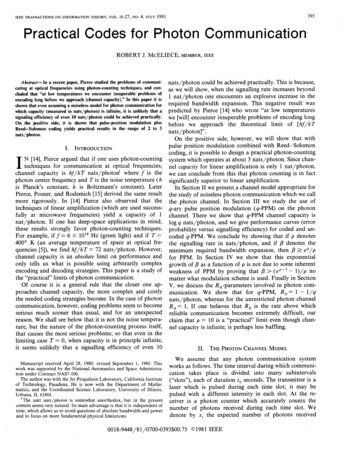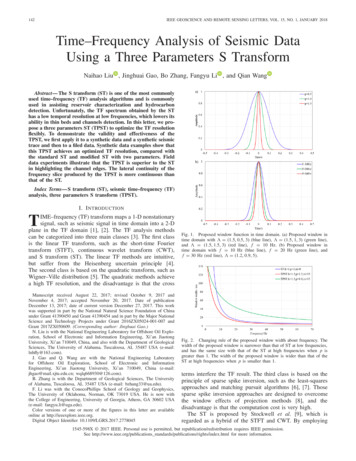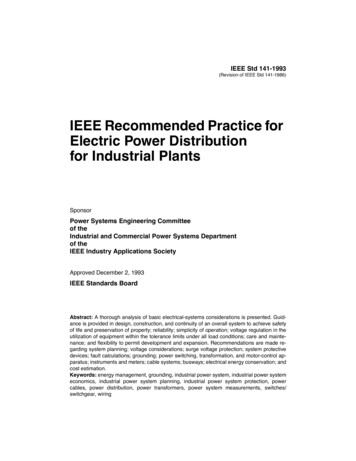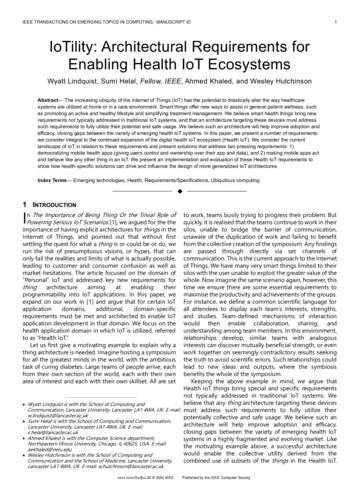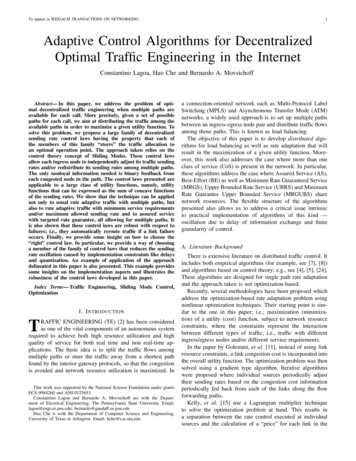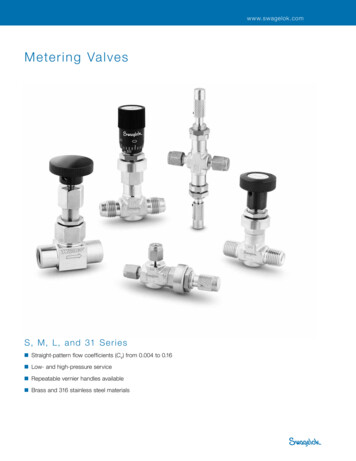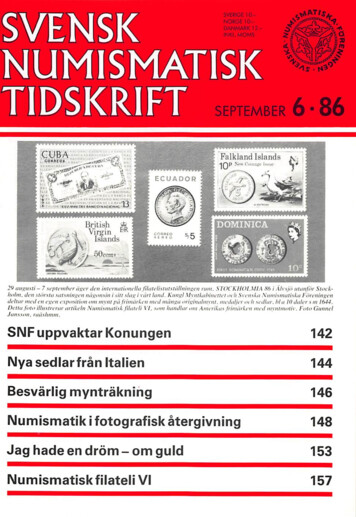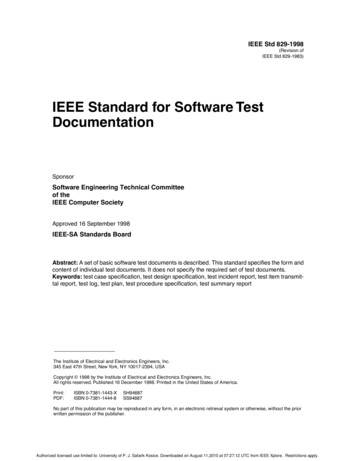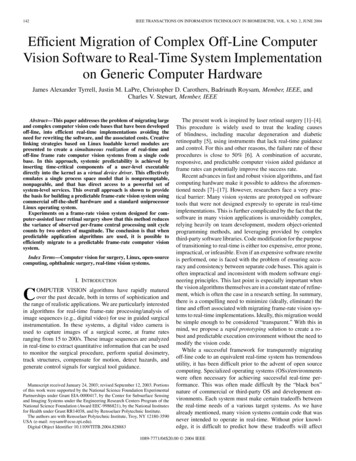
Transcription
142IEEE TRANSACTIONS ON INFORMATION TECHNOLOGY IN BIOMEDICINE, VOL. 8, NO. 2, JUNE 2004Efficient Migration of Complex Off-Line ComputerVision Software to Real-Time System Implementationon Generic Computer HardwareJames Alexander Tyrrell, Justin M. LaPre, Christopher D. Carothers, Badrinath Roysam, Member, IEEE, andCharles V. Stewart, Member, IEEEAbstract—This paper addresses the problem of migrating largeand complex computer vision code bases that have been developedoff-line, into efficient real-time implementations avoiding theneed for rewriting the software, and the associated costs. Creativelinking strategies based on Linux loadable kernel modules arepresented to create a simultaneous realization of real-time andoff-line frame rate computer vision systems from a single codebase. In this approach, systemic predictability is achieved byinserting time-critical components of a user-level executabledirectly into the kernel as a virtual device driver. This effectivelyemulates a single process space model that is nonpreemptable,nonpageable, and that has direct access to a powerful set ofsystem-level services. This overall approach is shown to providethe basis for building a predictable frame-rate vision system usingcommercial off-the-shelf hardware and a standard uniprocessorLinux operating system.Experiments on a frame-rate vision system designed for computer-assisted laser retinal surgery show that this method reducesthe variance of observed per-frame central processing unit cyclecounts by two orders of magnitude. The conclusion is that whenpredictable application algorithms are used, it is possible toefficiently migrate to a predictable frame-rate computer visionsystem.Index Terms—Computer vision for surgery, Linux, open-sourcecomputing, ophthalmic surgery, real-time vision systems.I. INTRODUCTIONCOMPUTER VISION algorithms have rapidly maturedover the past decade, both in terms of sophistication andthe range of realistic applications. We are particularly interestedin algorithms for real-time frame-rate processing/analysis ofimage sequences (e.g., digital video) for use in guided surgicalinstrumentation. In these systems, a digital video camera isused to capture images of a surgical scene, at frame ratesranging from 15 to 200/s. These image sequences are analyzedin real-time to extract quantitative information that can be usedto monitor the surgical procedure, perform spatial dosimetry,track structures, compensate for motion, detect hazards, andgenerate control signals for surgical tool guidance.Manuscript received January 24, 2003; revised September 12, 2003. Portionsof this work were supported by the National Science Foundation ExperimentalPartnerships under Grant EIA-0000417, by the Center for Subsurface Sensingand Imaging Systems under the Engineering Research Centers Program of theNational Science Foundation (Award EEC-9986821), by the National Institutesfor Health under Grant RR14038, and by Rensselaer Polytechnic Institute.The authors are with Rensselaer Polytechnic Institute, Troy, NY 12180-3590USA (e-mail: roysam@ecse.rpi.edu).Digital Object Identifier 10.1109/TITB.2004.828883The present work is inspired by laser retinal surgery [1]–[4].This procedure is widely used to treat the leading causesof blindness, including macular degeneration and diabeticretinopathy [5], using instruments that lack real-time guidanceand control. For this and other reasons, the failure rate of theseprocedures is close to 50% [6]. A combination of accurate,responsive, and predictable computer vision aided guidance atframe rates can potentially improve the success rate.Recent advances in fast and robust vision algorithms, and fastcomputing hardware make it possible to address the aforementioned needs [7]–[17]. However, researchers face a very practical barrier: Many vision systems are prototyped on softwaretools that were not designed expressly to operate in real-timeimplementations. This is further complicated by the fact that thesoftware in many vision applications is unavoidably complex,relying heavily on team development, modern object-orientedprogramming methods, and leveraging provided by complexthird-party software libraries. Code modification for the purposeof transitioning to real-time is either too expensive, error prone,impractical, or infeasible. Even if an expensive software rewriteis performed, one is faced with the problem of ensuring accuracy and consistency between separate code bases. This again isoften impractical and inconsistent with modern software engineering principles. This last point is especially important whenthe vision algorithms themselves are in a constant state of refinement, which is often the case in a research setting. In summary,there is a compelling need to minimize (ideally, eliminate) thetime and effort associated with migrating frame-rate vision systems to real-time implementations. Ideally, this migration wouldbe simple enough to be considered “transparent.” With this inmind, we propose a rapid prototyping solution to create a robust and predictable execution environment without the need tomodify the vision code.While a successful framework for transparently migratingoff-line code to an equivalent real-time system has tremendousutility, it has been difficult prior to the advent of open sourcecomputing. Specialized operating systems (OSs)/environmentswere often necessary for achieving successful real-time performance. This was often made difficult by the “black box”nature of commercial or third-party OS and development environments. Each system must make certain tradeoffs betweenthe real-time needs of a various target systems. As we havealready mentioned, many vision systems contain code that wasnever intended to operate in real-time. Without prior knowledge, it is difficult to predict how these tradeoffs will affect1089-7771/04 20.00 2004 IEEE
TYRRELL et al.: EFFICIENT MIGRATION OF COMPLEX OFF-LINE COMPUTER VISION SOFTWARE TO REAL-TIME SYSTEMa real-time system under different conditions. Environmentsbuilt around an embedded model, typically characterized bylightweight code modules and a small memory footprint, aresimply not appropriate for many vision systems that routinelyneed in excess of a gigabyte of random access memory (RAM).Complex event-driven real-time models may quickly obfuscatethe basic need for highly predictable synchronous executionof a frame-rate vision system.With the emergence of high-quality open-source community-developed OSs such as Linux, new options are availablefor the design and implementation of real-time vision systems.The present work is inspired and encouraged by the results ofHager and Toyama [10], Baglietto et al. [11], and Srinivasan etal. [17] using low-cost commercial off-the-shelf (COTS) computing platforms for real-time image processing applications,and builds upon our recent retinal image analysis algorithms.The following sections describe the proposed methodologyand lessons learned. Sections II-A–B describe the core methodology, in the context of the retinal application of direct interest.Section II-C summarizes previous and related work in thereal-time community highlighting some of the strengths anddeficiencies of various existing real-time frameworks fromwhich motivate the present work. Section III provides anin-depth discussion on details of our proposed method.II. MOTIVATION AND APPROACHA. MotivationAt the core of a frame-rate vision system are generally threeelements: a camera, a software component to perform imageprocessing, and hardware to generate an external control signal.The interaction of these three components typically follows ina synchronous or cyclic executive manner that is initiated bythe capture of an image by the camera and supporting hardware–firmware (e.g., frame grabber). If we turn our attention tothe camera, we notice two things: 1) modern COTS video systems can deliver true hard real-time performance with minimallatency and jitter and 2) modern hardware design allowing directmemory access (DMA) and bus mastering essentially free therest of the computer from processing overhead. Hence, it is nowpossible to capture frames in real-time and make them availablein memory (RAM) for processing on a central processing unit(CPU) that is largely unburdened by the imaging subsystem andvice versa. We exploit these developments in order to establishefficient and predictable real-time performance. The mechanismthat we propose is based on intelligent use of device drivers.In the Linux OS, device drivers are needed as an intermediaryto access a hardware device from user space. Device driversreside in kernel space and are only accessible from a user-levelprocess in a protected manner through the OS. In contrast,kernel-resident device drivers are free to access a number ofimportant system-level services not directly available to a standard user-level process. This includes direct access to DMA,teletype serial interface, high-resolution timers, and accessto other third-party device drivers installed on the machine.Device drivers can also share data across the user–kernelinterface or direct memoryboundary via the standardmapping.143Achieving frame-to-frame predictability is a primary issue forframe-rate vision systems operating in real-time. To achieve thishigh degree of predictability, we must first remove all real-timethreats associated with a modern multitasking OS. Fortunately,the Linux kernel provides a foundation for doing this by virtueof being nonpreemptive and not swapping kernel memory. Thisgives us the ability to emulate a single-process model directly inkernel by simply relinking the time-critical components of ourobject code into a virtual device driver. As the name implies,our approach is to create and use a standard Linux device driverwithout an associated physical device.It is important to note that Linux does offer a similar capability by operating in single-user mode, e.g., Linux “S.” Unfortunately, this execution mode is highly restrictive in termsof OS capabilities. For instance, there is no network supportand certain hardware may not be accessible. What is particularly problematic from the standpoint of a vision system is thatthere is no graphics or graphical user interface (GUI) supportin Linux S mode. This is not acceptable for clinical use whereoff-line monitoring in a GUI framework may need to coexistwith a real-time executive. Also, interrupt handling cannot behandled effectively from outside kernel space. In contrast, ourapproach has the advantage of being simple while achievinggood real-time predictability without restrictions on the operating mode of the host system. In short, we achieve a real-timeimplementation by simply adding a new virtual device to thecomputer.As will be illustrated, the virtual device driver is basically anencapsulated single process space model installed in the kerneland invoked via a call from user space. Under this model, allreal-time operations take place in the OS kernel under protectionfrom real-time threats. Hence, instead of using asynchronousreal-time processes or thread-level scheduling mechanisms thatinclude context switches, translation-lookaside buffer misses,cache misses–flushes, and page swapping, the entire computeris viewed as a single process system tasked with the sole purpose of devoting as many CPU cycles as possible, for a specifiedduration, to the direct execution of our real-time code. Therefore, we propose a paradigm based on transparent migration ofan off-line system to an equivalent online real-time system. Thekey is leveraging the inherent real-time capabilities of a standard Linux OS obviating the need for real-time extensions orextensive code rewriting.B. Real-Time Retinal Image AnalysisThe time-critical object code that is to be installed in kernelmust be capable of executing within the time bounds of thetarget system’s desired frame rates. In order to explore thereal-time feasibility of our proposed methodology, we introducesuch a system. A brief overview of this system is given here inorder to establish a context for the experiments to be presentedlater. A more detailed description is deferred to the Appendix.Our intention below is also to convey the fact that our code baseis highly complex with substantial memory and processingdemands; in short, we feel it is a prototypical frame-rate visionsystem.In this work, we have experimented with two computer visionapplications, both related to laser retinal surgery. In these appli-
144IEEE TRANSACTIONS ON INFORMATION TECHNOLOGY IN BIOMEDICINE, VOL. 8, NO. 2, JUNE 2004Fig. 1. Illustrating the retinal spatial mapping, referencing, and tracking applications of interest. Prior to surgery, a spatial map of the retina is constructed. Itconsists of mosaics (lower row), an indexing database, and surgical plans. Spatial referencing (Box A) is the technique of registering each on-line image framecaptured by a camera onto the spatial map. Correct registration is indicated in this figure by overlaying vascular features detected in the image frame over thecorresponding mosaic illustration in the lower row. Tracking (Box B) is the technique of rapidly registering an image frame to the previous frame assuming smallmotions. For simplicity, this figure omits mechanisms for handling various types of errors and exceptions.cations, it is of interest to locate specific points on the retina withthe highest achievable accuracy and reliability for the purpose ofguiding a surgical laser, monitoring the surgery, detection of errors, and performing beam shutoffs whenever appropriate. Theretinal images on the upper row in Fig. 1 were captured usinga digital mega-pixel video camera (1024 1024 12-bit pixels)mounted on a standard clinical instrument known as a funduscamera or biomicroscope [18]. This represents a partial angle(30 –60 ) flat projectional view of the complete curved retina.The branched structure in this image is the retinal vasculature.The vasculature is usually stable and can be used as a source ofspatial landmarks. These landmarks (features) are used to generate a spatial mosaic and map for the entire retina from a seriesof preoperative diagnostic images.The first application of interest, termed “spatial referencing,”is a method for absolute registration of an image frame captured by a digital camera to a preconstructed spatial map of thehuman retina. This method is summarized in Appendix A. Thesecond application, termed “robust tracking,” enables rapidregistration of successive image frames within a predictablecomputational budget. This latter algorithm is summarized inAppendix B. Fig. 1 illustrates the roles of these two algorithms.In this illustration, three successive image frames from the digital camera are presented in the uppermost row. The first frameis registered using the absolute spatial referencing algorithm.Since the second and third frames undergo small motionsrelative to the first, they are registered using the robust trackingalgorithm presented in Appendix B. The spatial referencingalgorithm is highly complex and unpredictable due to theopportunistic manner in which it reduces pixel processing.Therefore, it is only invoked when needed. For instance, whenthe first frame of a sequence is obtained following a fadeout,or after a large motion or a registration failure. In contrast,the robust tracking algorithm is very efficient and predictable.In short, these algorithms and data structures are capable ofrapidly estimating the position of the surgical laser anywhereon the retina for each image frame.Several factors contribute to the size and complexity of theseapplications. In order to perform highly precise registration,we use a 12-parameter quadratic transformation model to map
TYRRELL et al.: EFFICIENT MIGRATION OF COMPLEX OFF-LINE COMPUTER VISION SOFTWARE TO REAL-TIME SYSTEM145TABLE ISOURCE CODE PROFILE SHOWING RELATIVE SIZE OF MAJOR SOFTWARE COMPONENTS THAT WE LINK INTO A KERNEL MODULE.The VXL library is a third party standard C library. The RETL library is the Rensselaer tracinglibrary, and PUBL is a public RPI vision library. In addition to a static code size of 45 MB, weadd a 300-MB data segment to the final device driver in the form of a static buffer. We have experienced little difficulty loading our modules on a system with 1 GB of RAM.image coordinates to global coordinates in the preoperativeretinal mosaic [7]. The use of a quadratic transform is necessaryto mitigate the projective distortions resulting from the retinalcurvature combined with a weak perspective camera. Thistransform is estimated by a robust M-estimator [19] over a setof closest point correspondences between an image and themosaic. The estimate is found by employing a procedure callediteratively reweighted least squares (IRLS) [20]. In order toachieve fast computation in the face of large data volume, thespatial referencing method relies on extensive precomputeddata structures that trade storage in favor of speed. All ofthese algorithms are complex in their implementation, utilizingobject-oriented team programming effort, third-party libraries,and have substantial static and run-time memory requirements.Table I profiles the static size of the object code for the spatialreferencing software system. In addition to a static code sizeof 45 MB, this code typically requires roughly 300 MB ofdynamically allocated memory at run time.C. Real-Time Computing BackgroundFrom a computational standpoint, the combination oftechniques presented in the previous section enables spatialreferencing at extremely high speeds, approaching frame ratesnotwithstanding the high data rates and complexity. This formsthe necessary but insufficient basis for building a real-timespatial referencing system for ophthalmic applications. Stillneeded is a real-time OS (RTOS) that combines high throughputand low latency responsiveness to provide a predictable environment for meeting real-time deadlines.Choosing an appropriate RTOS requires understanding thecharacteristics of the target real-time application. Real-time applications are generally characterized as being hard or soft as described by their relative time sensitivity to a real-time deadline.A hard real-time application becomes invalid when a deadlineis not met. By contrast, soft real-time applications can toleratemore latency and the deadline constraint is less critical. Thiswork focuses on hard real-time frame-rate vision systems.The scheduling demands of a real-time application are animportant factor when classifying the nature of a real-timeapplication. One of the simplest scheduling models is cyclicexecutive or frame based execution [21], [22]. Applications ofthis type are characterized as being synchronous, often basedon periodic execution of logically sequential tasks. This typeof real-time system requires a trivial scheduling mechanismand is unlikely to benefit from complex parallel hardware configurations or multithreading. Applications that require trulypreemptive process/thread based scheduling to respond to asynchronous inputs are defined as being event driven [21], [22].Real-time frame-rate vision systems are naturally characterizedas being cyclic executive. Hence, this is the target model forthe proposed methodology.D. Previous WorkMaeda [23] demonstrated the efficiency gains associated withexecuting type-safe user-level programs directly in the kernelspace of a standard Linux OS. The idea is to eliminate the overhead associated with a transition across the protection boundaryseparating the user and kernel process space. This is an interesting approach that is based on type-safe-assembly languageextensions to user-level object code [24]. These extensions aredesigned to protect the integrity of the OS in the presence ofunstable or nefarious programs while at the same time greatlyreducing systemic overhead in applications that must frequentlyaccess low-level services. Importantly, this approach is consistent with our previously stated goals of maintaining a commondevelopment and real-time testing environment on a single platform utilizing a common code base. Unfortunately, the languageextensions used to make the user-level code “type safe” includearray bounds and other memory checking operations that introduce overhead that is unacceptable for our purposes. In reality, this type of methodology is probably best suited for softreal-time applications such as multimedia and communicationssystems that require frequent access to specialized system-levelservices.A similar approach to the one proposed here was developedby Srinivasan et al. [17]. Their approach uses COTS hardwarecomponents and a standard Linux OS to create a firm real-timeexecution environment. The notion of a firm real-time environment applies to time-critical real-time components that must unavoidably rely on nondeterministic OS services typically foundon a timesharing OS. Again, this approach is better suited formultimedia and communication applications and is not a trulyhard real-time method. An interesting aspect of this work however, is the introduction of a real-time priority-based schedulingmechanism into a standard Linux OS. This is a common approach for achieving true hard real-time performance from astandard Linux OS.RT-Linux [25] and TimeSys Linux [26] are proprietary Linuxvariants that offer an abstract view of the Linux kernel thatcan be configured dynamically to create a real-time frameworkwithout compromising the integrity of the standard Linux OS. Inshort, these two systems promise to offer true hard real-time performance without complex specialization of the existing Linux
146IEEE TRANSACTIONS ON INFORMATION TECHNOLOGY IN BIOMEDICINE, VOL. 8, NO. 2, JUNE 2004kernel. This is a powerful extension to what is already a wellsuited OS for real-time development.Both of these Linux RTOS variants are very appealing fromthe standpoint of transparent migration. The real problem is thatthey introduce a layer of abstraction into a standard Linux OSthat allows for micro-controlled scheduling of events. This isnecessary for event driven applications but has no real use inour application. Even more problematic is that the kernel mustbe made preemptable to handle asynchronous behavior. Thisforces kernel modules to be reentrant which raises serious compatibility issues for existing hardware device drivers. Of particular note is the fact that RTLinux is built around the use ofkernel modules implying that the steps that are described inthis paper have essentially already been taken. Unfortunately,it then imposes a mutually exclusive existence constraint between real-time executives and a standard Linux OS. This ismuch more extreme than our method of simply using standardLinux artifacts to achieve a real-time implementation.III. TRANSPARENT MIGRATION METHODOLOGYA. Overview of the MethodThe main components of the proposed methodology are listedbelow:1) encapsulate the application algorithms into a loadablekernel module (LKM);2) design a virtual device driver that emulates a singleprocess model in kernel;3) register device driver with Linux OS enabling user-levelaccess.The key to our approach for ensuring systemic predictability isembedding the image processing system into the Linux kernel.In this environment, it is possible to eliminate OS-level scheduling and interrupt overheads as well as mitigating the uncertainties introduced by a shared memory environment. The useof a device driver is a natural approach to achieving the necessary real-time performance while still allowing user- and kernellevel interaction. Under this model, all time-critical processingis deferred to a kernel-level process accessed directly from userspace as a device driver. When the time-critical processing iscompleted, the system returns to user space. From the standpoint of a frame-rate vision system, this implies that our devicedriver must directly interact with any necessary hardware components, such as video frame grabbers, from within the contextof a kernel process. This is essential because real-time executioncannot be guaranteed if any processing is to be done outside ofkernel mode. Fortunately, as noted earlier, Linux device driversare intended to work in this manner.B. LKMsIn this section, we describe LKMs and how they are usedto create a virtual device driver that emulates a single processmodel in kernel space. Typical examples of LKMs are devicedrivers but can include any functionality that might need to beshared by multiple processes. The idea of an LKM is to dynamically add executable object code directly to the Linux kernelwhile the system is running. LKMs are essentially no differentthan relocatable object modules created by a standard compilerlike GNU’s C compiler (GCC). They can be written in C or C and there are in fact surprisingly few restrictions on the natureand size of the code. We routinely create LKMs in excess of300 MB (refer to Table I for an overview of our code base size).The main difference is that LKMs must include two functionsand. Each function is guaranteed to be called exactly once.serves as the entry point into theThe functionmodule and is called when a kernel module is loaded via theutility [27]. Theutility is used to addLinuxmodules to the kernel while the system is running. After loading, functions and data in that module bea module usingcome part of the Linux kernel space. The Linux kernel is monolithic in the sense that all modules (including the kernel itself)share a single kernel address space. This means that functionsand data in one module are accessible from another. In addition, kernel functions can be invoked from a user-level process.These features of the Linux kernel model are important for thedevelopment of our real-time prototype.C. Kernel Module InsertionThe process of taking large-scale user-level software and realizing it as a kernel module is relatively straightforward provided one adheres to some constraints. Aside from the hazardsresulting from careless use, a potential problem is that the Linuxkernel is a restricted process space and does not provide muchof the functionality that user-level processes expect in order toexecute.Specifically, there are four key areas where user- andkernel-level processes differ:1) dynamic memory allocation;2) device input–output (I/O);3) global variables;4) stack management/usage.The first three differences can all be handled using the linkeroperating directly on the object code. The last issue is morerestrictive and in some cases can only be reconciled if certainconditions are already met by the existing object code.Under Linux, kernel modules do not have a module-specificheap and stack segment. This implies that kernel modulescannot allocate dynamic memory the way a user-level processcan. However, Linux does provide two specific kernel variants. The firstof the memory allocation system calledis called, which allocates physically contiguousblocks. This is ideal for our purposes but it becomes unreliable,as memory gets fragmented. The other is calledwhich allocates memory from the kernel’s virtual map. In fact,to load a kernel whenthis is the function used byit cannot be placed in physically contiguous real memory.These allocation functions have two problems: 1) they bothallocate memory blocks whose sizes are in powers of twoand 2) handling memory allocation requests during real-timeexecution is a potential source of uncertainty.To overcome these limitations, we developed a novel kernelmemory allocation function. As mentioned, the goal is to emulate a single process space directly in kernel. Hence, we introandthat operate on aduce our own version ofstatic buffer linked directly to the object code. In other words,
TYRRELL et al.: EFFICIENT MIGRATION OF COMPLEX OFF-LINE COMPUTER VISION SOFTWARE TO REAL-TIME SYSTEMFig. 2. Illustrating the technique for modifying the standard UNIX memoryallocation system call “malloc.” Note the g static bu er array which servesas our virtual data segment in kernel. Function fulfills virtual memory requestsby simply returning a pointer from this array.we have circumvented the fact that kernel modules do not have aheap segment by simply inserting a new allocation routine. Theroutine is described below,design of a special purposeand key programming lines are provided in Fig. 2.routine that isStarting with the standard GNUavailable in open-source form [28], we locate the functionwhich contains a call to the function. Thefunction, pronounced “S-Break,” is used to dynamicallyreallocate the data segment of the calling process. Specificallyit increments (or decrements) the break address, i.e., theaddress of the first location beyond the end of a process’s datawith a simplesegment. The key artifice is to replacepointer increment in our static buffer.source files andNext, we recompile the GNUlink them into a single new relocatable object module called” in the examples below. Having reimplemented“, we need to replace all instances of the standard versionin the code. This can be done quite easily in one step duringfunctionalitythe linking phase of compilation using theprovided by the linker. The idea is to substitute each referenceto a chosen procedure in an object module’s symbol table with” the olda reference to a new procedure. Hence, we “procedure with the new one, using a UNIX command of theformThe end result is that we have created an emulated heap segment for our real-time kernel modules. From the standpoint ofthe Linux virtual memory system, this heap segment exists as acontiguous memory zone that can only be used by our real-timemodule.The function wrapping technique used to substitute the kernelroutine can be used to resolve certain device I/O problems as well. Some simple I/O requests are trivially handled.or the C operatorcanFor instance, calls tobe wrapped using the kernel variant. Calls toare mapped to a virtual device, usuallyonLinux systems
142 IEEE TRANSACTIONS ON INFORMATION TECHNOLOGY IN BIOMEDICINE, VOL. 8, NO. 2, JUNE 2004 Efficient Migration of Complex Off-Line Computer Vision Software to Real-Time System Implementation on Generic Computer Hardware James Alexander Tyrrell, Justin M. LaPre, Christopher D. Carothers, Badrinath Roysam,


